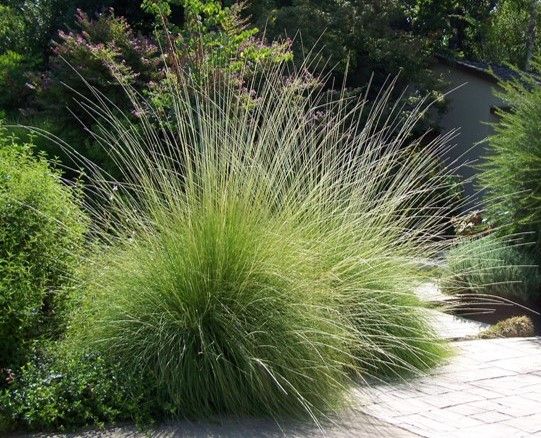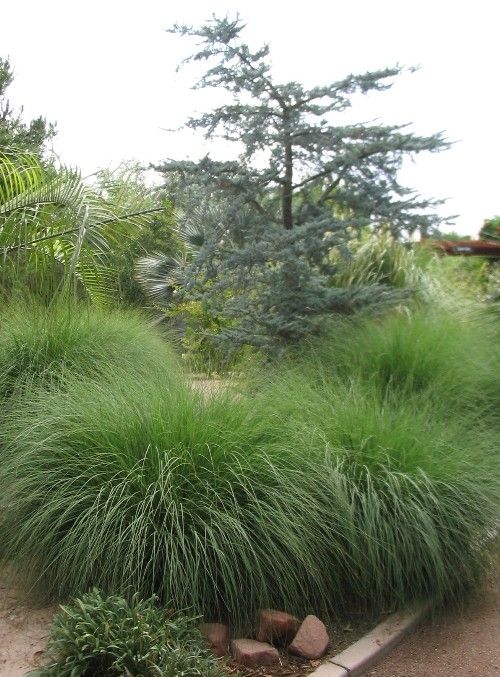Muhlenbergia rigens

Muhlenbergia rigens, commonly known as deergrass, stands as an emblematic grass species native to the western regions of North America.
Revered for its graceful appearance, ecological significance, and cultural importance, this perennial bunchgrass has found its place in a variety of landscapes, from natural habitats to urban gardens.
In this comprehensive article, we'll delve into the intricacies of Muhlenbergia rigens, exploring its botanical characteristics, habitat preferences, life cycle, ecological and cultural roles, conservation status, and care guidelines.
Botanical Description
Muhlenbergia rigens is characterized by its clumping growth habit, fine-textured foliage, and ethereal inflorescences.
The plant typically forms dense tussocks or clumps, with stems reaching heights of 2 to 4 feet (60 to 120 cm).
Its slender leaves are wiry and arching, ranging from green to bluish-green in color.
In late summer to fall, Muhlenbergia rigens produces delicate, feathery flower spikes that sway gracefully in the breeze, lending an enchanting quality to its appearance.
These flower spikes, ranging in color from tan to purplish-brown, persist through the winter months, adding visual interest to the landscape.
Habitat and Distribution
Deergrass is predominantly found in a variety of habitats across western North America, including grasslands, chaparral, and open woodlands.
It thrives in sunny locations with well-drained soils but can also tolerate partial shade and a degree of moisture.
Is native to regions spanning from British Columbia in Canada down to Baja California in Mexico.
It plays a crucial role in stabilizing soils, reducing erosion, and providing habitat and forage for a diverse array of wildlife species.
Life Cycle and Phenology of Muhlenbergia rigens
As a perennial grass, Muhlenbergia rigens undergoes a yearly life cycle marked by gradual growth and reproduction.
Spring marks the emergence of new shoots from the base of the plant, signaling the beginning of a new growing season.
Flowering typically occurs in late summer to fall, triggered by environmental cues such as changes in day length and temperature.
The airy flower spikes of Muhlenbergia rigens are wind-pollinated, resulting in small seeds that are dispersed by wind, water or animals.
Additionally, the grass can propagate vegetatively through rhizomes or tillers, allowing it to colonize new areas and form dense stands over time.
Conservation and Threats
While Muhlenbergia rigens is not currently listed as threatened or endangered, habitat loss and degradation pose significant threats to populations of the species.
Climate change exacerbates these threats, altering precipitation patterns and increasing the frequency and severity of droughts and wildfires.

Caring for Muhlenbergia rigens
Sunlight
Plant Muhlenbergia rigens in a location that receives full sunlight to partial shade.
Although it can tolerate some shade, it thrives in full sun.
Watering
Deergrass prefers moderate to low water levels once established.
Water deeply but infrequently, allowing the soil to dry out slightly between waterings.
Avoid overwatering to prevent root rot.
Soil
Provide well-drained soil with a neutral to slightly acidic pH.
So incorporate organic matter such as compost to improve soil structure and fertility.
Mulching
Apply a layer of organic mulch around the base of the plant to conserve moisture and suppress weed growth.
Keep the mulch several inches away from the stems to prevent rot.
Pruning
Minimal pruning is needed for Muhlenbergia rigens.
Remove dead or damaged foliage as necessary to maintain the plant's health and appearance.
By following these care guidelines, you'll be able to grow healthy, vibrant Muhlenbergia rigens plants in your garden or landscape.
Plus, you'll contribute to the preservation of this iconic grass species and the ecosystems it inhabits.
Whether used for erosion control or ornamental landscaping, deergrass offers lasting beauty and ecological value.
Leave a Reply
You must be logged in to post a comment.